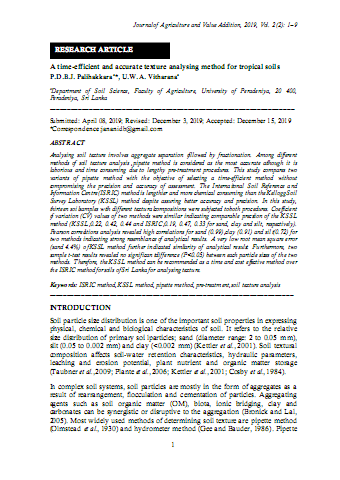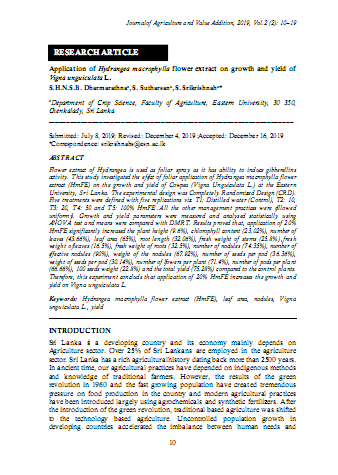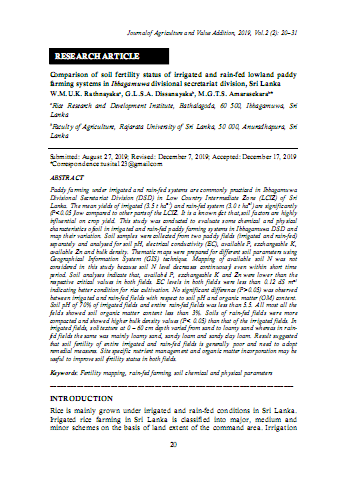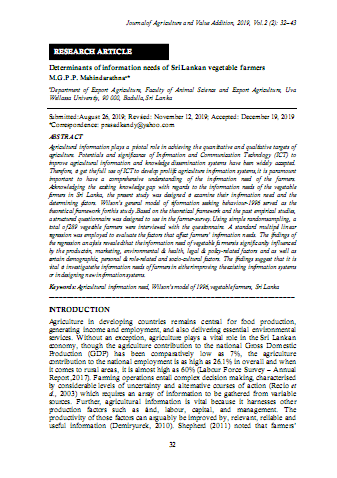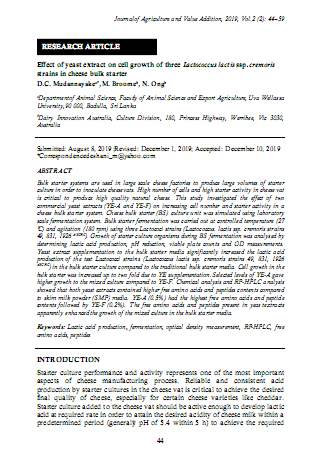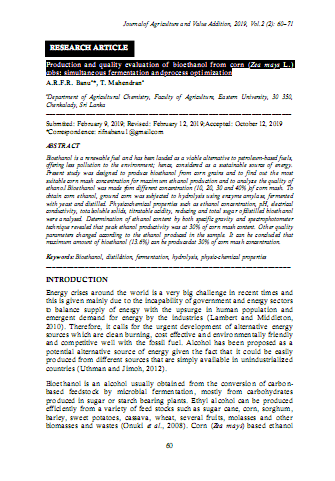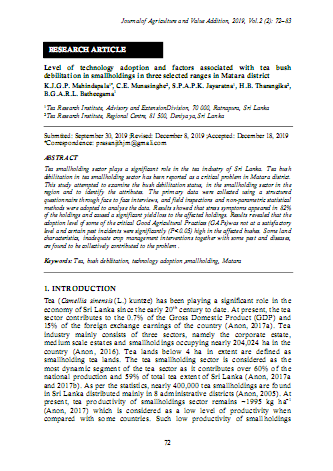
Volume 02 Issue 02
RESEARCH ARTICLES
01. A time-efficient and accurate texture analysing method for tropical soils
P.D.B.J. Palihakkaraa*, U.W.A. Vitharanaa
INFORMATION
Journal Title: Journal of Agriculture and Value Addition
Volume : 2 Issue 02
Page : 1- 09
Submitted: April 08, 2019; Revised: December 3, 2019; Accepted: December 15, 2019
*Correspondence: jananidb@gmail.com
ABSTRACT
Analysing soil texture involves aggregate separation followed by fractionation. Among different methods of soil texture analysis, pipette method is considered as the most accurate although it is laborious and time consuming due to lengthy pre-treatment procedures. This study compares two variants of pipette method with the objective of selecting a time-efficient method without compromising the precision and accuracy of assessment. The International Soil Reference and Information Centre (ISRIC) method is lengthier and more chemical consuming than the Kellogg Soil Survey Laboratory (KSSL) method despite assuring better accuracy and precision. In this study, thirteen soil samples with different textural compositions were subjected to both procedures. Coefficient of variation (CV) values of two methods were similar indicating comparable precision of the KSSL method (KSSL; 0.22, 0.42, 0.44 and ISRIC; 0.19, 0.47, 0.33 for sand, clay and silt, respectively). Pearson correlations analysis revealed high correlations for sand (0.99), clay (0.91) and silt (0.72) for two methods indicating strong resemblance of analytical results. A very low root mean square error (sand 4.4%) of KSSL method further indicated similarity of analytical results. Furthermore, two sample t-test results revealed no significant difference (P<0.05) between each particle sizes of the two methods. Therefore, the KSSL method can be recommended as a time and cost effective method over the ISRIC method for soils of Sri Lanka for analysing texture.
02. Application of Hydrangea macrophylla flower extract on growth and yield of Vigna unguiculata L
S.H.N.S.B. Dharmarathnaa, S. Sutharsana, S. Srikrishnaha*
INFORMATION
Journal Title: Journal of Agriculture and Value Addition
Volume : 2 Issue 02
Page : 10 – 19
Submitted: July 8, 2019; Revised: December 4, 2019; Accepted: December 16, 2019
*Correspondence: srikrishnahs@esn.ac.lk
ABSTRACT
Flower extract of Hydrangea is used as foliar spray as it has ability to induce gibberellins activity. This study investigated the effect of foliar application of Hydrangea macrophylla flower extract (HmFE) on the growth and yield of Cowpea (Vigna Unguiculata L.) at the Eastern University, Sri Lanka. The experimental design was Completely Randomized Design (CRD). Five treatments were defined with five replications viz. T1: Distilled water (Control), T2: 10, T3: 20, T4: 50 and T5: 100% HmFE. All the other management practices were followed uniformly. Growth and yield parameters were measured and analysed statistically using ANOVA test and means were compared with DMRT. Results proved that, application of 20% HmFE significantly increased the plant height (9.6%), chlorophyll content (23.02%), number of leaves (43.66%), leaf area (65%), root length (32.06%), fresh weight of stems (25.8%), fresh weight of leaves (16.5%), fresh weight of roots (32.5%), number of nodules (74.35%), number of effective nodules (90%), weight of the nodules (67.92%), number of seeds per pod (36.36%), weight of seeds per pod (30.14%), number of flowers per plant (71.4%), number of pods per plant (66.66%), 100 seeds weight (22.8%) and the total yield (75.28%) compared to the control plants. Therefore, this experiment concluds that application of 20% HmFE increases the growth and yield on Vigna unguiculata L.
03. Comparison of soil fertility status of irrigated and rain-fed lowland paddy farming systems in Ibbagamuwa divisional secretariat division, Sri Lanka
W.M.U.K. Rathnayakaa, G.L.S.A. Dissanayakab, M.G.T.S. amarasekarab*
INFORMATION
Journal Title: Journal of Agriculture and Value Addition
Volume : 2 Issue 02
Page : 20 – 31
Submitted: August 27, 2019; Revised: December 7, 2019; Accepted: December 17, 2019
*Correspondence: tusita123@gmail.com
ABSTRACT
Paddy farming under irrigated and rain-fed systems are commonly practiced in Ibbagamuwa Divisional Secretariat Division (DSD) in Low Country Intermediate Zone (LCIZ) of Sri Lanka. The mean yields of irrigated (3.5 t ha–1) and rain-fed system (3.0 t ha–1) are significantly (P<0.05) low compared to other parts of the LCIZ. It is a known fact that, soil factors are highly influential on crop yield. This study was conducted to evaluate some chemical and physical characteristics of soil in irrigated and rain-fed paddy farming systems in Ibbagamuwa DSD and map their variation. Soil samples were collected from two paddy fields (irrigated and rain-fed) separately and analysed for soil pH, electrical conductivity (EC), available P, exchangeable K, available Zn and bulk density. Thematic maps were prepared for different soil parameters using Geographical Information System (GIS) technique. Mapping of available soil N was not considered in this study because soil N level decreases continuously even within short time period. Soil analyses indicate that, available P, exchangeable K and Zn were lower than the respective critical values in both fields. EC levels in both fields were less than 0.12 dS m–1 indicating better condition for rice cultivation. No significant difference (P>0.05) was observed between irrigated and rain-fed fields with respect to soil pH and organic matter (OM) content. Soil pH of 70% of irrigated fields and entire rain-fed fields was less than 5.5. All most all the fields showed soil organic matter content less than 3%. Soils of rain-fed fields were more compacted and showed higher bulk density values (P< 0.05) than that of the irrigated fields. In irrigated fields, soil texture at 0 – 60 cm depth varied from sand to loamy sand whereas in rain- fed fields the same was mainly loamy sand, sandy loam and sandy clay loam. Result suggested that soil fertility of entire irrigated and rain-fed fields is generally poor and need to adopt remedial measures. Site specific nutrient management and organic matter incorporation may be useful to improve soil fertility status in both fields.
04. Determinants of information needs of Sri Lankan vegetable farmers
M.G.P.P. Mahindarathnaa*
INFORMATION
Journal Title: Journal of Agriculture and Value Addition
Volume : 2 Issue 02
Page : 32 – 43
Submitted: August 27, 2019; Revised: December 7, 2019; Accepted: December 17, 2019
*Correspondence: prasadkandy@yahoo.com
ABSTRACT
Agricultural information plays a pivotal role in achieving the quantitative and qualitative targets of agriculture. Potentials and significance of Information and Communication Technology (ICT) to improve agricultural information and knowledge dissemination systems have been widely accepted. Therefore, to get the full use of ICT to develop prolific agriculture information systems, it is paramount important to have a comprehensive understanding of the information need of the farmers. Acknowledging the existing knowledge gap with regards to the information needs of the vegetable farmers in Sri Lanka, the present study was designed to examine their information need and the determining factors. Wilson’s general model of information seeking behaviour-1996 served as the theoretical framework for this study. Based on the theoretical framework and the past empirical studies, a structured questionnaire was designed to use in the farmer-survey. Using simple random sampling, a total of 289 vegetable farmers were interviewed with the questionnaire. A standard multiple linear regression was employed to evaluate the factors that affect farmers’ information needs. The findings of the regression analysis revealed that the information need of vegetable farmers is significantly influenced by the production, marketing, environmental & health, legal & policy-related factors and as well as certain demographic, personal & role-related and socio-cultural factors. The findings suggest that it is vital to investigate the information needs of farmers in either improving the existing information systems or in designing new information systems.
05. Effect of yeast extract on cell growth of three Lactococcus lactisssp. cremoris strains in cheese bulk starter
D.C. Mudannayakea*, M. Broomeb, N. Ongb
INFORMATION
Journal Title: Journal of Agriculture and Value Addition
Volume : 2 Issue 02
Page : 44 – 59
Submitted: August 8, 2019; Revised: December 1, 2019; Accepted: December 10, 2019
*Correspondence: deshani_m@yahoo.com
ABSTRACT
Bulk starter systems are used in large scale cheese factories to produce large volumes of starter culture in order to inoculate cheese vats. High number of cells and high starter activity in cheese vat is critical to produce high quality natural cheese. This study investigated the effect of two commercial yeast extracts (YE-A and YE-F) on increasing cell number and starter activity in a cheese bulk starter system. Cheese bulk starter (BS) culture unit was simulated using laboratory scale fermentation system. Bulk starter fermentation was carried out at controlled temperature (27ºC) and agitation (180 rpm) using three Lactococi strains (Lactococcus. lactis ssp. cremoris strains 49, 831, 1926 ASCRC). Growth of starter culture organisms during BS fermentation was analysed by determining lactic acid production, pH reduction, viable plate counts and OD measurements. Yeast extract supplementation to the bulk starter media significantly increased the lactic acid production of the test Lactococci strains (Lactococcus lactis ssp. cremoris strains 49, 831, 1926 ASCRC) in the bulk starter culture compared to the traditional bulk starter media. Cell growth in the bulk starter was increased up to two fold due to YE supplementation. Selected levels of YE-A gave higher growth to the mixed culture compared to YE-F. Chemical analysis and RP-HPLC analysis showed that both yeast extracts contained higher free amino acids and peptides contents compared to skim milk powder (SMP) media. YE-A (0.5%) had the highest free amino acids and peptide contents followed by YE-F (0.2%). The free amino acids and peptides present in yeast extracts apparently enhanced the growth of the mixed culture in the bulk starter media.
06. Production and quality evaluation of bioethanol from corn (Zea mays L.) cobs: simultaneous fermentation and process optimization
A.R.F.R. Banua*, T. Mahendrana
INFORMATION
Journal Title: Journal of Agriculture and Value Addition
Volume : 2 Issue 02
Page : 60 – 71
Submitted: February 9, 2019; Revised: February 12, 2019; Accepted: October 12, 2019
*Correspondence: rifnabanu1@gmail.com
ABSTRACT
Bioethanol is a renewable fuel and has been lauded as a viable alternative to petroleum-based fuels, offering less pollution to the environment; hence, considered as a sustainable source of energy. Present study was designed to produce bioethanol from corn grains and to find out the most suitable corn mash concentration for maximum ethanol production and to analyze the quality of ethanol. Bioethanol was made from different concentration (10, 20, 30 and 40%) of corn mash. To obtain corn ethanol, ground corn was subjected to hydrolysis using enzyme amylase, fermented with yeast and distilled. Physicochemical properties such as ethanol concentration, pH, electrical conductivity, total soluble solids, titratable acidity, reducing and total sugar of distilled bioethanol were analysed. Determination of ethanol content by both specific gravity and spectrophotometer technique revealed that peak ethanol productivity was at 30% of corn mash content. Other quality parameters changed according to the ethanol produced in the sample. It can be concluded that maximum amount of bioethanol (13.6%) can be produced at 30% of corn mash concentration.
07. Level of technology adoption and factors associated with tea bush debilitation in smallholdings in three selected ranges in Matara district
K.J.G.P. Mahindapala*, C.E. Munasinghe,S.P.A.P.K Jayaratna, H.B Tharangika, B.G.A.R.L. Batheegama
INFORMATION
Journal Title: Journal of Agriculture and Value Addition
Volume : 2 Issue 02
Page : 72 – 83
Submitted: September 30, 2019; Revised: December 8, 2019; Accepted: December 18, 2019
*Correspondence: prasanjithjm@gmail.com
ABSTRACT
Tea smallholding sector plays a significant role in the tea industry of Sri Lanka. Tea bush debilitation in tea smallholding sector has been reported as a critical problem in Matara district. This study attempted to examine the bush debilitation status, in the smallholding sector in the region and to identify the attributes. The primary data were collected using a structured questionnaire through face to face interviews, and field inspections and non-parametric statistical methods were adopted to analyse the data. Results showed that stress symptoms appeared in 82% of the holdings and caused a significant yield loss to the affected holdings. Results revealed that the adoption level of some of the critical Good Agricultural Practices (GAPs) was not at a satisfactory level and certain pest incidents were significantly (P<0.05) high in the affected bushes. Some land characteristics, inadequate crop management interventions together with some pest and diseases, are found to be collectively contributed to the problem.



